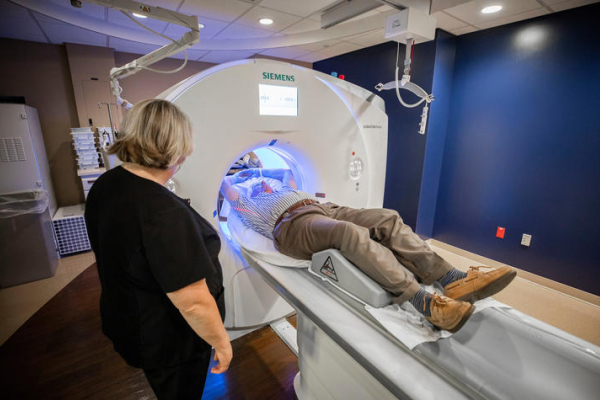$2.7M NIH grant supports wearable technology system to improve recovery from leg fractures

Researchers at the University of Kentucky and Vanderbilt University received a five-year, $2.7 million grant from the National Institutes of Health (NIH) to study the use of wearable technology for better patient recovery from shinbone fractures and repair surgeries.
Brian Noehren, Ph.D., associate dean for research and professor in the College of Health Sciences and director of the UK Human Performance and Biomotion Laboratories, and Karl Zelik, associate professor of mechanical engineering in the Center for Rehabilitation Engineering and Assistive Technology at Vanderbilt University, are co-principal investigators.
Peter Volgyesi, a research scientist from Vanderbilt's Institute for Software Integrated Systems, and Paul Matuszewski, M.D., associate professor of orthopaedic surgery at the UK College of Medicine, are co-investigators on the project.
Patient recovery following a fractured tibia (shinbone), and the surgical procedure to repair it, often results in an inability to fully return to work a year later in 47% of patients, the researchers said.
The research team is using a noninvasive wearable sensor system that fits inside a shoe and novel machine learning algorithms developed at Vanderbilt to monitor tibial bone force in daily life.
The goal of the study, funded by NIH’s National Institute of Arthritis and Musculoskeletal and Skin Diseases, is to measure how much tibial force patients experience during daily activities and in their rehabilitation programs, and how tibial forces early in recovery affect long-term functional outcomes.
“We will be able to identify how the rate at which people load their limbs affects their recovery,” Noehren said. “From that information, we can develop new interventions to help people recover more quickly to return to work and their prior activity levels.”
More than 490,000 Americans fracture their tibia each year, resulting in significant health care costs with more than 569,000 hospital stays and 800,000 physician office visits. Clinicians currently prescribe a rehabilitation exercise program that exposes a patient’s tibia to increasing forces to gradually recover the ability to do pre-injury activities. However, there is no way of knowing how much tibial force patients experience at home during daily activities and in their rehabilitation programs to inform effective rehabilitation treatment.
Zelik said the future of rehabilitation health care requires new tools that can help patients and doctors monitor and manage loading on bones and other tissues inside the body, especially in the weeks following surgery. “That’s what we’re developing, a new class of wearable technology to enable remote monitoring of musculoskeletal loading, which can accelerate patient recovery and improve long-term health outcomes,” he added.
Research reported in this publication was supported by the National Institute of Arthritis and Musculoskeletal and Skin Diseases of the National Institutes of Health under Award Numbers R01AR081002 and R01AR080708. The content is solely the responsibility of the authors and does not necessarily represent the official views of the National Institutes of Health.
UK HealthCare is the hospitals and clinics of the University of Kentucky. But it is so much more. It is more than 10,000 dedicated health care professionals committed to providing advanced subspecialty care for the most critically injured and ill patients from the Commonwealth and beyond. It also is the home of the state’s only National Cancer Institute (NCI)-designated cancer center, a Level IV Neonatal Intensive Care Unit that cares for the tiniest and sickest newborns, the region’s only Level 1 trauma center and Kentucky’s top hospital ranked by U.S. News & World Report.
Credits
Ryan Clark (Public Relations & Strategic Communication)

